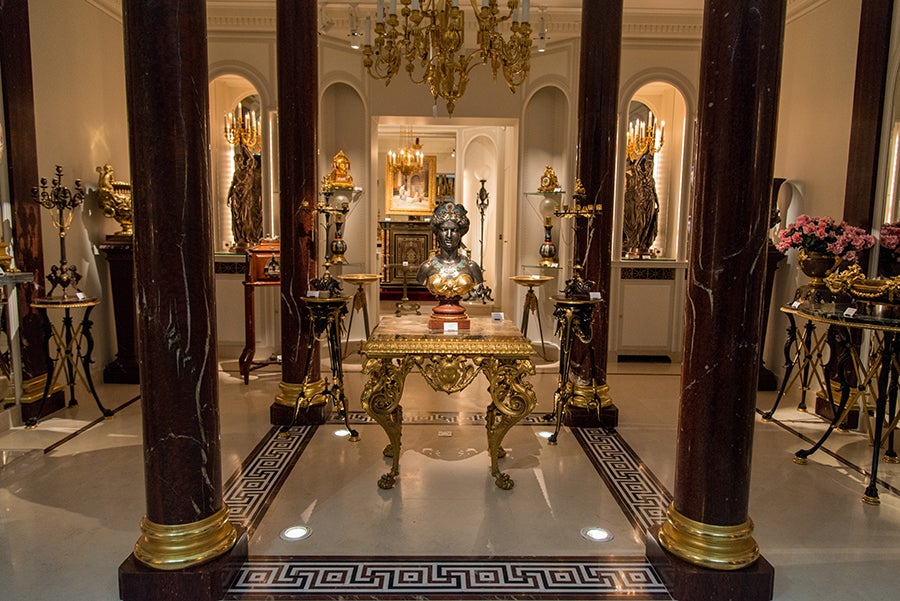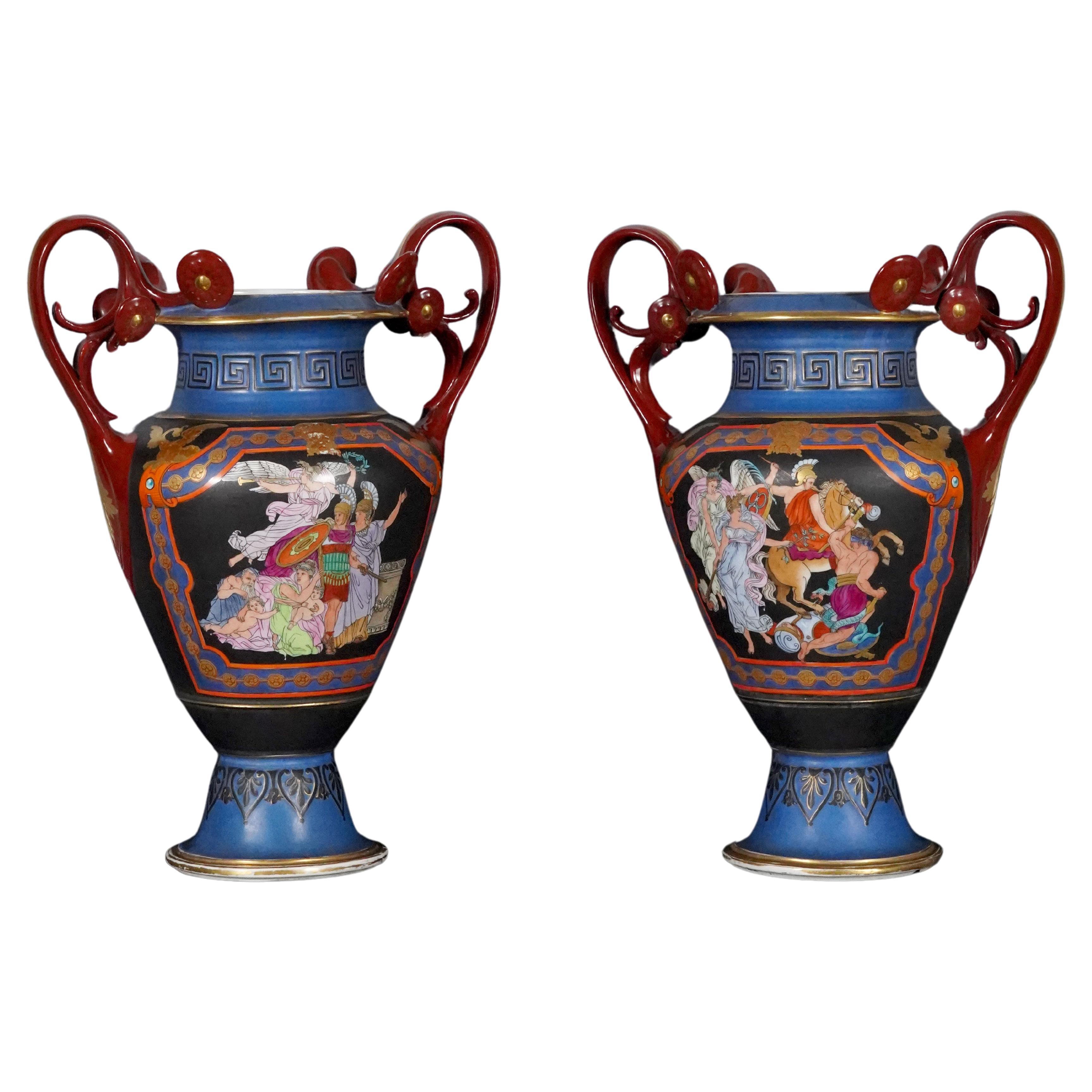Items Similar to Neo-Greek Silvered Bronze Bowl Attributed to G. Servant, France, circa 1880
Want more images or videos?
Request additional images or videos from the seller
1 of 7
Neo-Greek Silvered Bronze Bowl Attributed to G. Servant, France, circa 1880
About the Item
Beautiful silvered bronze neo-Greek style bowl in a circular shape, adorned on the body with female masks in the antique style and on the sides with handles in the shape of busts of lionesses ending in palmettes. The fluted pedestal is surrounded by a frieze of palmettes. It rests on a Griotte marble molded base with four lions’ paws ending with windings.
Georges Emile Henri Servant (1828-c.1890), who took over his father in 1855 at their foundry, rue Vieille-du-Temple, in Paris, specialized in the production of neo-Egyptian style clocks, very popular in France since 1860’s, and also the making of Greek style decorative objects. He drew considerable attention to the high quality of his bronzes at the 1855 Paris Universal Exhibition and then at the 1862 London Exhibition. At this time Servant exported up to 40% of his production, principally to the United States, where for instance, his clocks were sold with great success by Louis Tiffany Inc. or Hamann & Roche of New York. But his success came really at the 1867 Paris Universal Exhibition, where he was awarded a gold medal for his neo-Greek and Egyptian works (Les Merveilles de l’Exposition Universelle de 1867, t. II, p° 165 & 167). He was even awarded in 1874 the « Ordre national de la Légion d’Honneur », France’s highest official mark of recognition. Servant participated once again successfully at the 1878 Paris Universal Exhibition, where he not only exhibited vases and small bronze pieces of furniture, but was also a member of the jury for the class of bronze pieces of art. He finally retired shortly before the 1889 Paris Universal Exhibition.
- Attributed to:Georges Emile Henri Servant (Maker)
- Dimensions:Height: 10.83 in (27.5 cm)Width: 13.78 in (35 cm)Depth: 11.03 in (28 cm)
- Style:Greek Revival (In the Style Of)
- Materials and Techniques:
- Place of Origin:
- Period:
- Date of Manufacture:circa 1880
- Condition:Wear consistent with age and use.
- Seller Location:PARIS, FR
- Reference Number:

About the Seller
4.9
Vetted Seller
These experienced sellers undergo a comprehensive evaluation by our team of in-house experts.
Established in 1997
1stDibs seller since 2018
74 sales on 1stDibs
Typical response time: <1 hour
Associations
International Confederation of Art and Antique Dealers' Associations
- ShippingRetrieving quote...Ships From: PARIS, France
- Return PolicyA return for this item may be initiated within 7 days of delivery.
More From This SellerView All
- Pair of Neo-Greek Pedestals, attributed to G.Servant, France, Circa 1880By Georges Emile Henri ServantLocated in PARIS, FRPair of patinated and gilded bronze turntable pedestals with for each of them, three paw feet, headed by stylized lion muzzles, ornated with beaded chains and joined by a fine foliate stretcher. The belt is adorned by a banded frieze cast in low-relief representing an ancient scene : “The Battle of the Lapithes and the Centaurs”. These pedestals can be associated with the "Vases de Bacchus", presented by G. Servant at the 1867 Exposition Universelle, on which the similar ornamentation is applied. (Reproduced in « Merveilles de l'Exposition Universelle de 1867 », Jules Mesnard, p°167) Biography : Georges Emile Henri Servant...Category
Antique 1880s French Greek Revival Pedestals
MaterialsBronze
- Pair of Neo-Greek Bronze Candelabras Attributed to G.Servant, France, Circa 1870By Georges Emile Henri ServantLocated in PARIS, FRRare pair of Greek style candelabras made in patinated bronze and gilded bronze, attributed to G. Servant. Each with ten light arms topped by a heron shaped extinguisher. Decorated with various Greek style motifs such palmets, pine cones ans water leaves. Standing on a small triangular architecture presenting a theatre mask and reposing on a tripod base formed with lion paw feet. Georges Emile Henri Servant (circa 1828-1890), who took over his father in 1855 at their foundry, rue Vieille-du-Temple, in Paris, specialized in the production of neo-Egyptian style clocks, very popular in France since 1860’s, and also the making of Greek style decorative objects. He drew considerable attention to the high quality of his bronzes at the 1855 Paris Universal Exhibition and then at the 1862 London Exhibition. At this time Servant exported up to 40% of his production, principally to the United States, where for instance, his clocks were sold with great success by Louis Tiffany Inc. or Hamann & Roche of New York. But his success came really at the 1867 Paris Universal Exhibition, where he was awarded a Gold Medal for his neo-Greek and Egyptian works (Les Merveilles...Category
Antique 1870s French Greek Revival Table Lamps
MaterialsBronze
- Pair of Neo-Greek Floor Lamps Attributed to G. Servant, France, Circa 1870By Georges Emile Henri ServantLocated in PARIS, FRRare pair of Greek style floor lamps made in patinated bronze attributed to G. Servant, each surmounted of a frosted glass globe engraved of stars and a Greek motif frieze. The body of the vase, decorated with Greek style patterns such as palmets, Greek motif frieze and water leaves, stands on a shaft decorated with deer heads. Fine chains are connected to a delicate butterfly. The set is based on tripod legs with lion claw feet alternating large palmets. Height : 183 cm (72 in.) ; 213 cm (83 3/4 in.) with glass shades ; Diameter : 43 cm (19 2/3in.) Georges Emile Henri Servant (1828-c.1890), who took over his father in 1855 at their foundry, rue Vieille-du-Temple, in Paris, specialized in the production of neo-Egyptian style clocks, very popular in France since 1860’s, and also the making of Greek style decorative objects. He drew considerable attention to the high quality of his bronzes at the 1855 Paris Universal Exhibition and then at the 1862 London Exhibition. At this time Servant exported up to 40% of his production, principally to the United States, where for instance, his clocks were sold with great success by Louis Tiffany Inc. or Hamann & Roche of New York. But his success came really at the 1867 Paris Universal Exhibition, where he was awarded a gold medal for his neo-Greek and Egyptian works (Les Merveilles...Category
Antique 1860s French Greek Revival Floor Lamps
MaterialsBronze
- Neo-Greek Gueridon Attributed to F. Barbedienne, France, Circa 1880By Louis-Constant Sevin, Ferdinand BarbedienneLocated in PARIS, FRA similar model was exposed at the 1889 Paris Universal Exhibition ( see picture attached) Patinated and gilded bronze gueridon with four paw feet joined by X-shaped stems, attributed to Sévin and Barbedienne. Round green marble top mounted with a bronze rim adorned with oves and pearls motif. Born in 1821 and dead in Paris in 1888, Louis-Constant Sévin was apprenticed to the parisian sculptor Marneuf. In 1839, he joined the sculptor-modelors Phénix and Joyau, as designer, and designed silver-smith’s objects for famous firms like Denière, Froment-Meurice, Morel and Duponchel. During the Revolution in 1848, C. Sévin joined Morel in London, as workshop manager and designed pieces that Morel exhibited in 1851. Back in France in 1851, C. Sévin went to Limoges and designed models for the porcelain factories of Jouhanneaud and Dubois of which many pieces were exhibited at the Universal Exhibition in 1855. From this date on, he worked for Ferdinand Barbedienne as sculptor-ornemanist until the end of his life. Sévin’s works are considerable, he designed furniture bronzes for the « hôtel de La Païva ». At the London Exhibition in 1862, he was awarded a medal « pour l’excellence artistique des meubles qu’il a dessinés et qui sont exposés par Barbedienne » : for the artistic excellence of the furniture he designed and which is exhibited by F. Barbedienne. He won a second class medal at the Union centrale des Arts décoratifs Exhibition in 1863 and was awarded a gold medal as « cooperator ». F. Barbedienne said that posterity would remember Sévin’s compositions. The most extraordinary object designed by C. Sévin for F. Barbedienne, was a Renaissance style gilded bronze monumental clock...Category
Antique 1880s French Greek Revival Center Tables
MaterialsMarble, Bronze
- Neo-Egyptian Bronze and Marble Clock Attributed to G.Servant, France, Circa 1870By Georges Emile Henri ServantLocated in PARIS, FRA black and red marble clock in the shape of an Egyptian temple attributed to G. Servant, flanked by double columns inscribed with hieroglyphs and ornated with a winged uraeus, all made in two patina bronze. The clock is surmounted by a patinated bronze sphinx. Resting on four bronze faces wearing the nemes and terminating in lion paw feet. Georges Emile Henri Servant (circa 1828-1890) who took over his father in 1855 at their foundry, rue Vieille-du-Temple, in Paris, specialized in the production of neo-Egyptian style clocks, very popular in France since 1860s, and also the making of Greek style decorative objects. He drew considerable attention to the high quality of his bronzes at the 1855 Paris Universal Exhibition and then at the 1862 London Exhibition. At this time Servant exported up to 40% of his production, principally to the United States, where for instance, his sphinx clocks were sold with great success by Louis Tiffany Inc. or Hamann & Roche of New York (A similar clock is now exposed at the Metropolitan Museum of Art, New York). But his success came really at the 1867 Paris Universal Exhibition, where he was awarded a gold medal for his neo-Greek and Egyptian works (Les Merveilles...Category
Antique 1870s French Egyptian Revival Mantel Clocks
MaterialsMarble, Bronze
- Pair of Neo-Greek Wall-Lights Attributed to F. Barbedienne, France, Circa 1880By Ferdinand BarbedienneLocated in PARIS, FRA pair of neo-Greek wall-light sconces executed in two patina bronze attributed to F. Barbedienne. The central up-turned foliage stem, surmounted by a Greek style vase...Category
Antique 1880s French Greek Revival Wall Lights and Sconces
MaterialsBronze
You May Also Like
- Antique French Christofle Silver on Bronze Baccarat Bowl Centerpiece, 1880sLocated in New Orleans, LAAntique French Christofle silver on bronze Baccarat bowl centerpiece, Circa 1880-1890.Category
Antique 19th Century French Decorative Bowls
MaterialsCrystal, Bronze
- Circa 1880 Storck & Sinsheimer German Silver Fruit BowlLocated in Chapel Hill, NCA Storck & Sinsheimer, Hanau, Germany, c.1880, silver fruit bowl with elaborate baroque style repousse fruit motif panels between florid, pierced panels....Category
Antique 1880s German Baroque Decorative Bowls
MaterialsSilver
- Silver Plate Greek Kylix BowlLocated in Los Angeles, CASilver plate Greek kylix bowl - for the Metropolitan Museum of Art by Gorham - a beautiful decorative or practical bowl for candy nuts or conversation. ...Category
20th Century Classical Greek Decorative Bowls
MaterialsSilver Plate
- Silver Plated French Bacchanalian Jardiniere, Circa 1880Located in Dallas, TXProduced in France, circa 1880, this impressive silver plated jardiniere has elements of Greek mythology, making it Neoclassical style. On each side of the jardiniere is a mascaron o...Category
Antique 1880s French Neoclassical Planters, Cachepots and Jardinières
MaterialsMetal, Silver Plate
- Swedish Double Handled Bowl Attributed to HöganäsBy Höganäs KeramikLocated in St.Petersburg, FLA unique and attractive stoneware bowl attributed to Höganäs Keramik. Great color palette and presence with tones of organic yellow, brown, and terra-cotta.Category
Vintage 1930s Swedish Organic Modern Decorative Bowls
MaterialsCeramic
- 19th Century Burmese Solid Silver Handcrafted Bowl, circa 1880Located in Royal Tunbridge Wells, KentAntique late 19th century Burmese (Myanmar) exceptional solid silver repousse' bowl, repousse' decorated in high detail and relief with scenes of agriculture, elephants helping to move timber, villagers sawing and carrying wood...Category
Antique 19th Century Burmese Decorative Bowls
MaterialsSilver
Recently Viewed
View AllMore Ways To Browse
Greece Objects
Greek Bronze
Bronze Greek
Antique Gold And Silver Objects
Antique Greek Object
Antique Greek Style Furniture
Greek French Bronze
Four Bowls
Antique Bronze Bowl
Drew Antique
The Servant
Greek Gold Decorative Object
Bust Sold
Antique Greek Bronze
Neo Bedroom
Exhibition 1862
Greek Revival Style
Greek Lion





